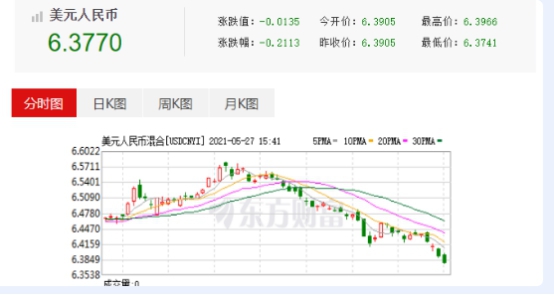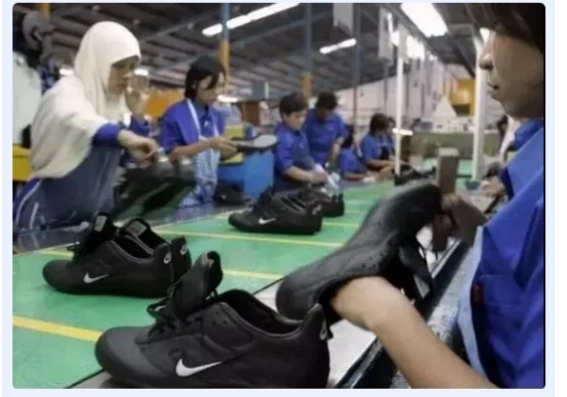Textile Information
Inventory·The most valuable hot spots of the week
▶▶▶▶
This week the RMB exchange rate hit a three-year high, industry giants announced another shutdown, polyester factories welcomed their seventh promotion, and the Vietnam epidemic Urgent…
Let’s take a look at what’s new this week!
RMB exchange rate hits three-year high

Since April, the U.S. dollar index has weakened, depreciating by 2.1%, and the RMB exchange rate against the U.S. dollar has continued to strengthen. The onshore RMB rose by 2.18%, rising by more than 1,400 points; offshore The RMB has risen by more than 1,500 points, or 2.73%.
On May 26, the central parity rate of the RMB exchange rate was quoted at 6.4099 yuan per US dollar, an increase of 184 basis points from the previous trading day, hitting a new high in the past three years. , one step away from the 6.3 yuan era.
On that day, the exchange rates of onshore RMB and offshore RMB against the US dollar fluctuated and rose, both exceeding the 6.4 yuan mark, and entering the era of 6.3 yuan. Thinking back to a year ago, the RMB exchange rate against the US dollar was still 7.1. In one year, it rose by more than 7,100 basis points.
The editor has something to say: Such an increase is of course a huge benefit to importing companies, especially in the current situation where the prices of some bulk commodities continue to rise sharply. The appreciation of the RMB It will also reduce the pressure caused by the surge in commodity prices. But for export companies, when this mountain comes down, business becomes more difficult.
Industry giants announce shutdown again

The epidemic in India continues to be severe, with the total number of deaths from the epidemic exceeding 300,000. On May 24, Fengtai announced again that it would extend the shutdown until May 30. Fengtai’s current Indian production line accounts for more than 20% of the total production capacity, and it will be supported by other overseas factories during the shutdown.
A part-time lecturer at New York University and a Chinese management consultant believes that if the epidemic in India does not improve before the summer, some large companies may withdraw from India.
The editor has something to say: Originally, the global supply chain was leaving, and India was expected to become the “world’s factory.” However, due to the disruption caused by the epidemic, multinational companies have transferred orders back to China.
Polyester factory welcomes seventh promotion
As the end of the month approaches, and a week has passed since the last promotion, downstream and terminal factories have a certain demand for replenishment. This Friday, factories will plan more discount promotions. , the market center of gravity may decline significantly.
On May 28, the polyester factory has a promotion ranging from 100 to 450 yuan. In addition to the previous three promotions, this is the fourth time this month. It is also the seventh promotion in the past two months.
The editor has something to say: For many weaving companies, they will not buy in large quantities due to promotions. They believe that there will be price reductions in the future, which is not enough for polyester factories. It’s a way to clear inventory.
Vietnam’s epidemic situation is urgent
Under the impact of the fierce new wave of COVID-19 epidemic, India and some Southeast Asian countries have suffered heavy losses. Now, Vietnam is also lost. In the past week, hundreds of people have been diagnosed with COVID-19 in Vietnam every day. Judging from the numerical value alone, it seems that the epidemic is still under control. However, for Vietnam, the meaning of this number is very different.
This is the first large-scale outbreak in Vietnam since the global outbreak of the new coronavirus in 2020. The epidemic is still spreading rapidly in northern Vietnam.
The editor has something to say: The Southeast Asian epidemic has a relatively large impact on my country’s textile market, but what makes people question is whether there are really orders that can be returned to China? The obvious answer is very little.
Market Review
Polyester : PTA prices rebounded sharply this week. As international oil prices rose rapidly this week, and at the same time, some fabrics were stocked and stocked in the terminal textile market, the goods were sold relatively well. PTA prices began to recover. The current PTA internal market transaction discussions are around 4600-4680 yuan/ton.
In terms of polyester filament, this The price of polyester filament was mainly stable this week. Some raw material factories once again carried out price reduction promotions on Friday, which promoted the shipment of raw materials to a certain extent. However, the downstream market has become accustomed to weekly promotions of raw materials and is hoarding raw materials.� is less common.
In terms of profit, PX suffered a larger loss this week It expanded slightly last week, and its current loss potential reaches US$115/ton. As for PTA, it is still losing money this week, and its loss has now narrowed to around 110 yuan/ton. In terms of ethylene glycol, it entered a profitable state this week, with a current profit of US$8/ton. In terms of polyester filament, polyester prices have stabilized overall this week, but costs have risen sharply and profits have begun to shrink; FDY profits have reached 262 yuan/ton; POY150D profits have decreased, with current profits of 517 yuan/ton; DTY150D profit margins have shrunk, with current profits of 212 yuan/ton. Yuan / ton.
In terms of operating rate, the PTA weekly average this week The operating rate was concentrated at 74.8%, down 1.4% from last week; the real-time operating rate was 74.8%, and the real-time effective operating rate was 82.2%. In terms of polyester, the average load of polyester this week was concentrated at 91.9%, an increase of 1.3% from last week. In terms of weaving, the operating rate of weaving manufacturers has recently rebounded to around 71%.
In terms of production and sales, this week’s market The trading atmosphere for polyester yarn is relatively sluggish, and the performance of polyester production and sales is average. Only during the polyester factory promotion period on Friday, the average production and sales performance of polyester yarn is better, and the average production and sales during the rest of the time are 20-50%.
In terms of inventory, statistics from China Silk Capital Network According to the data, the overall inventory of the polyester market is now concentrated in 12-25 days; in terms of specific products, POY inventory is around 9-21 days, FDY inventory is around 12-16 days, and DTY inventory is around 15-28 days .
Weaving: From the Shengze Index of the Ministry of Commerce It can be seen that the transaction atmosphere of the textile market has improved in recent times, and some fabric products have begun to increase in volume. This is mainly because downstream textile companies have stocked up and stocked autumn and winter fabrics, but other fabric products still performed mediocrely. Raw material prices have been mainly stable this week, with some raw material specifications rising slightly. There was another price reduction promotion on Friday. This promotion is the fourth this month. Driven by the promotion, production and sales are generally good. However, the impact on fabric prices is limited, and the overall price is still mainly stable. As the sales volume of gray fabrics has improved slightly, the weaving operating rate has ended its decline in the past two months and has begun to rebound slightly. The operating rate in Shengze area is now stable at around 71%. At the same time, the downstream stockpiling and stocking of autumn and winter fabrics has allowed gray fabrics to be sold. Better, the overall gray cloth inventory has now dropped to around 40.8 days.
Printing and dyeing: The activity level of the printing and dyeing market this week Generally speaking, the quantity of gray fabrics entering warehouses has dropped slightly, and the operating rate has plummeted to 81%. The traditional textile peak season has officially ended. Under the off-season conditions, orders from printing and dyeing factories have obviously begun to weaken. The “market orders” that were the main force in the early stage have gradually come to an end, the workshop production space is much more relaxed, and the queues for pressing cards have almost disappeared.
Products with high elasticity, four-way stretch and nylon have relatively good orders, while other fabrics lack highlights. The current start-up rate of 81% is basically the lowest start-up rate in the textile market after the year. Therefore, the delivery time is also shortened, and the overall delivery time has been reduced to about 8 days.
Outlook
On the last weekend of May, the market sentiment seemed to be picking up a bit, but This does not mean that the market will get better in June, and new challenges are about to arise…
</p







